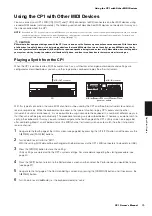
Controller Section
CP1 Owner’s Manual
23
Interna
l Design of the C
P
1
Controller Section
The CP1 controller section consists of the keyboard, pitch bend wheel, knobs, foot pedals, and other input devices used
while playing. It is important to bear in mind that the keyboard itself does not generate any sound; instead, it sends note,
velocity, and other performance-related signals to the built-in tone generator section, which then produces sounds in
response. In the same way, the other devices in the controller section also send data to the tone generator whenever they
are operated or adjusted. Specifically speaking, the signals produced and sent by the keyboard and other controllers
are MIDI messages, and therefore, they can also be sent to other MIDI devices or a computer via the MIDI [OUT]
connector or [USB TO HOST] port.
TIP
Plugging in a USB flash-memory device
Use the [USB TO DEVICE] port at the right end of the control panel for plugging in
USB flash-memory devices. Before plugging in a flash-memory device, ensure that
its connector matches the port and that both are oriented in the same direction.
NOTE
Although the CP1’s connector is compatible with the USB 1.1 standard, you can
connect and use USB 2.0 flash-memory devices. In such a case, however, data will be
transferred at the USB 1.1 speed only.
Precautions when using [USB TO DEVICE] port
When plugging a USB flash-memory device into the CP1’s built-in [USB TO DEVICE] port, be sure to handle it with care and follow
the important precautions below.
NOTE
For more details on how to use your USB flash-memory device, see the owner’s manual that came with it.
Supported USB memory devices
Only USB memory devices of the flash-memory variety can be used with the CP1. Furthermore, this instrument does not
necessarily support all commercially available USB flash-memory devices, and Yamaha cannot guarantee normal operation with
every such device on the market. Before purchasing a USB flash-memory device for use with the CP1, therefore, please visit the
following web page to confirm whether or not it is supported:
http://www.yamahasynth.com/
Working with USB flash-memory devices
With a USB flash-memory device plugged into the CP1, you can use it to save Performances that you have created and to load
previously-saved Performances back into the instrument.
Formatting a USB flash-memory device
Certain types of USB flash-memory device must be formatted before they can be used with the CP1. Whenever you plug such a
device into the [USB TO DEVICE] port, a message prompting you to format it will be displayed on-screen. To do so, follow the
instructions presented on page 62.
CAUTION
When a USB flash-memory device is formatted, all data saved on it will be permanently erased. Before formatting a memory device,
therefore, ensure that it contains no irreplaceable data.
Write protection
Certain types of USB flash-memory device can be write-protected to prevent data from being accidentally erased. If your USB
memory contains irreplaceable data, we suggest that you use write protection to prevent accidental erasure. Meanwhile, if you
need to save data on a USB flash-memory device, be sure to disable write-protect.
Removing USB flash-memory devices
Before removing a USB flash-memory device from the [USB TO DEVICE] port, ensure that the CP1 is not currently accessing it in
order to save or load data.
CAUTION
Care should be taken to avoid plugging in and removing USB flash-memory devices with excessive frequency. If this precaution is
not observed, the CP1 may freeze and cease operating. In addition, a USB flash-memory device should never be removed before it
has been fully mounted or while it is being accessed by the CP1 in order to save or load data. Data on the flash-memory device or
on the instrument itself may be corrupted as a result of such action, and there is also a danger that the USB flash-memory device
could be permanently damaged.
















































